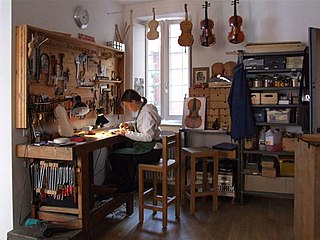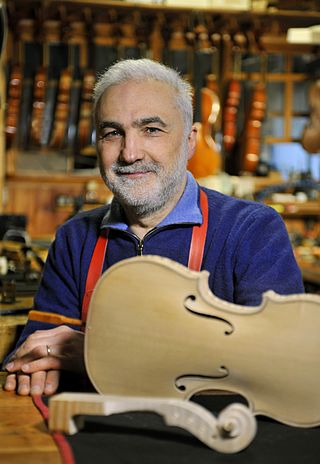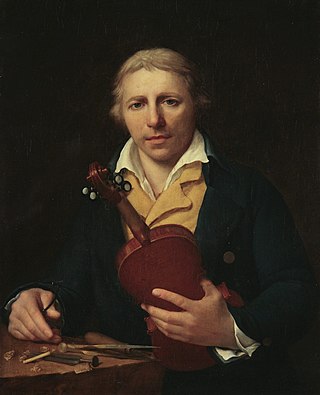
A luthier is a craftsperson who builds or repairs string instruments that have a neck and a sound box. The word luthier is originally French and comes from the French word for "lute". The term was originally used for makers of lutes, but it came to be used in French for makers of most bowed and plucked stringed instruments such as members of the violin family and guitars. Luthiers, however, do not make harps or pianos; these require different skills and construction methods because their strings are secured to a frame.
The Guarneri, often referred to in the Latinized form Guarnerius, is the family name of a group of distinguished luthiers from Cremona in Italy in the 17th and 18th centuries, whose standing is considered comparable to those of the Amati and Stradivari families.

Jean-Baptiste Vuillaume was a French luthier, businessman, inventor and winner of many awards. His workshop made over 3,000 instruments.

Il Cannone Guarnerius of 1743 is a violin created by the Italian luthier Giuseppe Antonio Guarneri of Cremona (1698–1744).
Sesto Rocchi (1909–1991) was a violin maker from Reggio Emilia, Italy.

Bartolomeo Giuseppe "del Gesù" Guarneri was an Italian luthier from the Guarneri family of Cremona. He rivals Antonio Stradivari (1644–1737) with regard to the respect and reverence accorded his instruments, and for many prominent players and collectors his instruments are the most coveted of all. Instruments made by Guarneri are often referred to as Del Gesùs.

Roberto Regazzi is a notable contemporary violin maker and scholar who received his initiation in the craft from Otello Bignami. Regazzi lives and works in Bologna.

Simone Fernando Sacconi was an expert Italian violin maker and restorer who studied fellow luthier Antonio Stradivari extensively during his lifetime.

Carlo Bisiach (1892–1968) was a violin maker born in Milan Italy. Bisiach's work contributed to the rebirth of violin making in the region after the difficult times of World War I and World War II. After working with his father Leandro in Milan and then Siena, Carlo established himself at Florence in 1922. The most talented of Leandro's sons, Carlo went on to develop his own style quite separate from the Antoniazzi-derived work of his father and brothers.

Giuseppe Fiorini (1861–1934) was an Italian luthier and is considered one of the most important Italian violin makers. He built his first instrument at the age of 16 while working in Bologna. He established Rieger and Fiorini in Germany from 1888, then lived in Zurich during World War 1 and Rome from 1923.
Luigi Rinaldo Legnani was an Italian virtuoso guitarist, singer, composer and luthier.
Giuseppe Bernardo Lecchi was an Italian violin maker.

Nicolas Lupot was one of the most illustrious French luthiers of his time.
Enrico Ceruti (1806–1883) was an Italian violin maker born in Cremona, known as the last of the great line of violinmakers of Cremona.
Rembert Wurlitzer Co. was a distinguished firm in New York City that specialized in fine musical instruments and bows.
Tim Jansma was a notable contemporary luthier; a maker of violins, violas and cellos. He apprenticed at William Moennig and Son in Philadelphia and graduated from the International School of Violin Making of Cremona, Italy. The original Jansma Violin Shop was in Cremona, Italy and later was permanently established in Fremont, Michigan, USA in 1977. Jansma instruments are sold around the world to professional musicians and students.
Charles François Gand (1787–1845) was one of the foremost violin makers/luthier and dealers of his time.
Pietro Capodieci is an Italian musician and violin maker based in Rome.

The Violin Museum, formerly the Stradivarius Museum, is a musical instrument museum located in Cremona. The museum is best known for its collection of stringed instruments that includes violins, violas, cellos, and double basses crafted by renowned luthiers, including Antonio Stradivari and Giuseppe Guarneri del Gesù.

The Le Brun Stradivarius of 1712 is a violin made by Italian luthier Antonio Stradivari of Cremona (1644–1737). It is the only violin from Stradivari’s golden period known to have been owned and played by the violinist Niccolò Paganini. When sold at a Sotheby's auction in London in November 2001 it achieved one of the highest prices ever paid for a violin at auction, and became the most expensive instrument in Europe.










